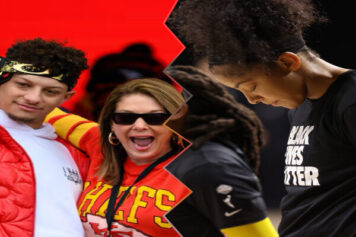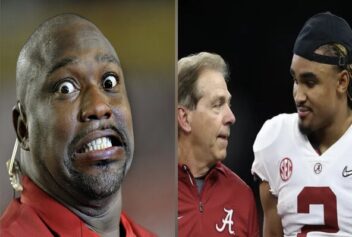Super Bowl XLVIII has been billed as immovable object (Seahawks defense) vs. unstoppable force (Broncos offense), but nobody is as stuck in place as the Seattle Seahawks wide receivers. Like Sisyphus, rolling the same boulder up the same, identical hill every day for eternity, Seahawks wide out Doug Baldwin wants a little respect for his comrades.
“I don’t have a chip on my shoulder,” Baldwin inveighed after the NFC Championship about not receiving enough credit. “I have a boulder on my shoulder.”
He echoes the sentiments of each of Seattle’s Angry Bird receivers.
Note to self, do not insinuate the Seahawks stable of receivers is inferior. The Denver Broncos are the ones letting passes bounce off their hooves at the fourth-highest rate in the league. The Seahawks were last in dropped passes during the regular season.
But you don’t have to attack the greatness of Denver’s receivers Tonya Harding style to appreciate Seattle’s receiving corps.
Everybody should know the story of Percy Harvin’s journey by now. He’s the versatile receiver that should be wearing a protective helmet similar to the 10 gallon hat-sized one Wes Welker has wrapped around his dome.
Sidney Rice was the Seahawks best deep threat until tearing his ACL. Both are capable of being 1,000 yard receivers. Thus, neither was available to participate in the Seahawks’ Super Bowl quest.
In their absence, the Seahawks receiving corps became the John Doe show. Golden Tate, Jermaine Kearse and Baldwin were as invisible to the media’s narrative as Mike Jones was on the Southern rap scene.
You can’t really blame anyone who identified this unit as Seattle’s weak link. The Seahawks roster is a chimera which can decimate teams in a variety of ways. However, because their run-first scheme and impermeable defense doesn’t require them to sling the ball interminably and none of their young wideouts was a first round pick, Seattle’s receiving corps is perceived to be a relative weakness.
Being the Super Bowl team since the 2006 Chicago Bears without a 1,000 yard receiver doesn’t endear them to quality historical offensive company. However, this offense isn’t inept. They’re just selective.
Seattle’s physically imposing ground and pound attack promotes a terrestrial matriculation of the football. In combination with Wilson’s athleticism from the pocket and his propensity for keeping his eyes trained downfield allowing his receivers to surge past safeties, escape blanket coverages and separate from corners for big gains Seattle's receivers are able to lie waiting in the grass before striking.
Among all NFL receivers with at least 50 catches, Baldwin is second in yard per target according to NFL Advanced Stats. Wilson’s 51-yard scramble right, dart back left to evade a pass rusher, then throw to Baldwin against the Niners in the NFC Championship was a microcosm of how the Seahawks exploits defenses.

Marshawn Lynch collects his pound of flesh on every carry and play-action is the lubrication that powers the passing attack.
Tate was a second round draft pick overshadowed by his Notre Dame quarterback Jimmy Clausen. Baldwin is only the fourth-most prolific Stanford product to barrel into the NFL.
Pete Carroll is the fox in the Stanford hen house. He’s made it an art of pilfering athletes Jim Harbaugh recruited to The Farm.
Kearse was also a former Pac-12 adversary of Carroll’s. In his final season as USC coach, Carroll was on the loser’s end of an upset loss to Washington. Kearse caught two of the final throws from Jake Locker for 41 yards that put the Huskies in position for the game-winning field goal.
In case Richard Sherman gave you the wrong impression, the Seahawks don’t just squawk about opposing team’s wide receivers.
Marshawn Lynch lets his action speak for itself. Russell Wilson is the even-keeled old soul under center who rarely goes off script, Harvin is the most gifted athlete with the flawed body, Tate is the veteran Seahawk and Kearse is the late riser, but Baldwin is the hype man on the offensive side of the ball and the emotional leader.
Unlike Denver, the Seahawks offense doesn’t feature a premier pass-catching tight end. Starter Zach Miller averaged approximately two catches and 27 yards per game. Wilson is probably the only mobile quarterback in the league that doesn’t utilize his tight ends often.
After Sidney Rice tore his ACL, Baldwin was converted from a slot receiver to flanker and split end as well.
However, an inadvertent dig from an article piece by the USA Today’s Tom Pelissero which labeled the Seahawks receivers as pedestrian has been bullet board material for Baldwin since mid-December. Not since Freddie Mitchell thanked his hands for being so great has a receiver thought so lowly of been so outspoken.
After reeling in six catches for 106 yards in the NFC Championship, Baldwin flexed the bravado that’s become typical for Stanford athletes not named Jonathan Martin.
“It irritates the hell out of me when guys constantly want to talk about (receivers), talking about we’re average, we’re pedestrian,” Baldwin added. “Well guess what? We’re going to walk our ass to the Super Bowl as pedestrians.”
That was restrained compared to the vitriolic reaction he expressed on social media to the USA Today article last month.
"Who the (expletive) wrote this article, didn't put any stats in it, then obviously didn't watch any tape, because if they would have saw the tape, they would see that we're making plays all over the (expletive) field?," Baldwin wrote in his own blood, sweat and tears.
"We're the most efficient receiving corps in the NFL and we're one of the tops in big plays and we don't throw the ball that much. We're one of the last teams in the NFL to throw the ball, but yet we're in the top in explosives. C'mon. Somebody's got to say something. Somebody's got to do some research here. I can't do it for you."
To avoid getting on Baldwin's bad side, here are the raw numbers via the Seattle Times:
He was thrown to only 73 times during the regular season (4.6 times per game), yet he produced 50 receptions, 778 yards and five touchdowns.
Baldwin caught passes on 68.5 percent of his targets this season. Interesting comparison: Calvin Johnson, the NFL’s best receiver and one of the most targeted, made good on only 53.8 percent of his targets. Denver’s Demaryius Thomas — another huge star who had 92 receptions, 1,430 yards and 14 touchdowns on a team that throws a lot and spreads the ball around — was successful on 64.3 percent of his targets.
The Super Bowl could be the pulpit to showcase his web hands, quickness and route running proficiency on the grandest stage. It couldn’t come at a better time. As Tate braces for free agency, Baldwin’s role in the offense could increase next season.
Cris Carter and Keyshawn Johnson drew Baldwin’s ire for calling the Seahawks receivers appetizers, but Baldwin piled on Pelissero, more discreetly than Sherman did with Crabtree.
Doug Baldwin just called me over to let me know I've been replaced by Cris Carter and Keyshawn Johnson who called #Seahawks WRs "appetizers"
— Tom Pelissero (@TomPelissero) January 20, 2014
Following his rookie season, Baldwin was singled out by Football Outsiders as its No. 1 breakout star of the 2012 season. While being used a slot receiver, he became the first undrafted rookie since the AFL-NFL merger to lead his team in receiving yardage.
It took a year later than expected, but Baldwin’s exponential growth was evident this season.
Lynch is the offensive linchpin, yet the Seahawks trust Wilson’s arm and their available receivers in short yardage do-or-die moments.
On 3rd and 3, with under three minutes remaining against the Saints, Wilson opted to air out a back shoulder throw rather than play it safe and hand off to Marshawn Lynch or throw a quick slant to pick up just enough yards for the first.

Tate is best remembered for allegedly pulling down with the Fail Mary pass against Green Bay during the 2012 regular season that essentially ended the NFL officials strike.
Kearse made perhaps the biggest catch of the entire Seahawks season against the 49ers in the fourth quarter of the NFC Championship Game. Had it not been for Harvin’s injury, he wouldn’t have been on the field for the ballsy fourth down attempt on the abandoned Patch Zebra Detroit play call that changed the course of NFL playoff history.
After the Seahawks burned a timeout and realized they were out of field goal range, they settled on going for it from the Niners 35. Sandwiched in between Tate and Baldwin in a shotgun trips right formation, Kearse spotted a flag thrown after Aldon Smith jumped on Wilson’s double snap count, adjusted to a vertical route and Wilson promptly unloaded a high arching ball on the free play that landed in Kearse’s hands at the apex of his leap and just out of cornerback Carlos Rogers’ reach. Kearse landed in end zone paydirt and the Seahawks never relinquished their 20-17 lead.
Most football fans outside the Emerald City and subscribers to USA Today in particular would describe the Seahawks receiving corps with the same searing adjective Richard Sherman would use to blister Michael Crabtree with. They’d describe them as mediocre, subpar, second-rate.
Now you know better. Don't do it unless you want to risk Baldwin intentionally dropping that that boulder on you.



